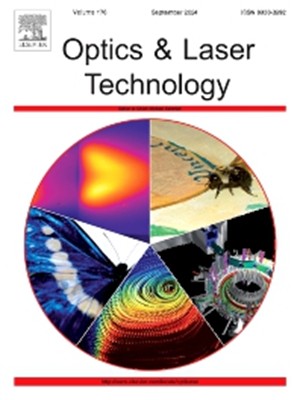Effect of Cu interlayers on element diffusion and properties of laser welded Ti6Al4V/Inconel 718 dissimilar joints
IF 4.6
2区 物理与天体物理
Q1 OPTICS
引用次数: 0
Abstract
The dissimilar joints of TC4 and IN718 were successfully welded by using a fiber laser and Cu interlayer with varying thicknesses. This research focused on the interface on the TC4 side, where two transition layers were identified: a Ti-rich layer and a Ti-poor layer. The Ti-rich layer primarily consisted of Ti2Cu and Ti2Ni. Meanwhile, the Ti-poor layer contained a range of harder and more brittle intermetallic compounds (IMCs), such as TiNiCu, TiCr2 and TiFe2, with the thickness increasing as the interlayer thickness increased. The fracture of all the joints occurred at the interface on the TC4 side. Insufficient Cu introduction tended to cause the penetration of Ti into Layer B, reacting with elements such as Fe and Cr to form more brittle and hard IMCs. Conversely, excess Cu in the molten pool, resulting from the introduction of a 0.4 mm Cu interlayer could lead to the formation of much (Cu, Ni), which caused softening and a deterioration in the tensile strength of the joint. When a 0.3 mm Cu interlayer was employed, the diffusion of Ti and Cu reached equilibrium, resulting in an average tensile strength of 319 MPa for the obtained joint, which was 28 % higher than that of the joint with a 0.4 mm interlayer.
求助全文
约1分钟内获得全文
求助全文
来源期刊
CiteScore
8.50
自引率
10.00%
发文量
1060
审稿时长
3.4 months
期刊介绍:
Optics & Laser Technology aims to provide a vehicle for the publication of a broad range of high quality research and review papers in those fields of scientific and engineering research appertaining to the development and application of the technology of optics and lasers. Papers describing original work in these areas are submitted to rigorous refereeing prior to acceptance for publication.
The scope of Optics & Laser Technology encompasses, but is not restricted to, the following areas:
•development in all types of lasers
•developments in optoelectronic devices and photonics
•developments in new photonics and optical concepts
•developments in conventional optics, optical instruments and components
•techniques of optical metrology, including interferometry and optical fibre sensors
•LIDAR and other non-contact optical measurement techniques, including optical methods in heat and fluid flow
•applications of lasers to materials processing, optical NDT display (including holography) and optical communication
•research and development in the field of laser safety including studies of hazards resulting from the applications of lasers (laser safety, hazards of laser fume)
•developments in optical computing and optical information processing
•developments in new optical materials
•developments in new optical characterization methods and techniques
•developments in quantum optics
•developments in light assisted micro and nanofabrication methods and techniques
•developments in nanophotonics and biophotonics
•developments in imaging processing and systems

 求助内容:
求助内容: 应助结果提醒方式:
应助结果提醒方式:


